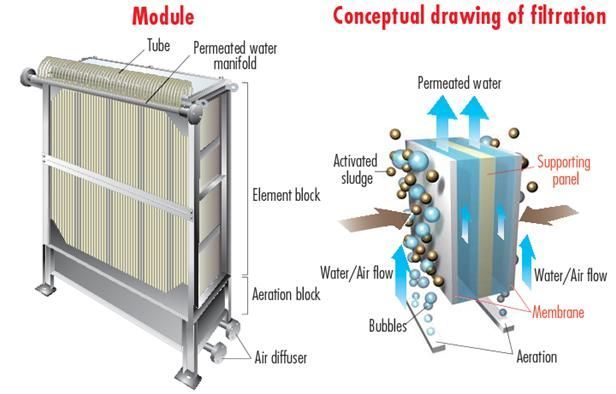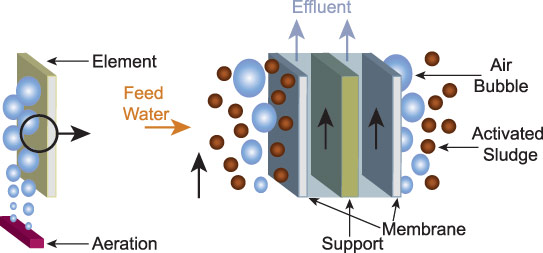Membrane Bioreactor as a Sustainable Solution for High-Volume Wastewater Treatment
Just How Membrane Layer Bioreactors Are Transforming Water Filtration Systems
The appearance of membrane layer bioreactors (MBRs) represents a substantial development in the area of water purification, combining organic treatment procedures with cutting-edge membrane filtering technologies. As international water shortage increases, the duty of MBRs in facilitating drinkable water reuse and lasting water administration comes to be progressively critical.
Review of Membrane Layer Bioreactors
Membrane bioreactors (MBRs) stand for a considerable development in water filtration modern technology, as they incorporate organic therapy processes with membrane layer purification. This integration improves the efficiency of wastewater therapy by using microorganisms to deteriorate natural pollutants while at the same time using semi-permeable membranes to separate treated water from put on hold solids and microorganisms.
The MBR system usually contains a biological reactor where the microbial population metabolizes pollutants, complied with by a membrane layer filtration unit that retains biomass and permits just tidy water to travel through. This twin capability causes greater effluent quality compared to conventional treatment approaches. MBRs can be run in both set and continual flow settings, using versatility in design and application.
Additionally, MBRs are characterized by their small impact, making them ideal for urban setups with room constraints. Membrane Bioreactor. They likewise enable the recuperation of water for reuse, thus adding to water sustainability campaigns. While MBR modern technology has actually obtained appeal in industrial and metropolitan applications, its operational complexities and power needs require mindful consideration throughout implementation. In general, MBRs are at the forefront of boosting water treatment performance and top quality, showcasing the capacity for ingenious options in ecological administration.
Benefits of MBR Innovation
The combination of organic therapy with membrane filtering supplies many benefits for water purification procedures. One of the key benefits of Membrane layer Bioreactor (MBR) technology is its capacity to efficiently remove both not natural and organic contaminants, resulting in high-quality effluent. The membranes serve as a physical obstacle, avoiding put on hold solids and virus from passing through, which improves the general security and reliability of cured water.
Furthermore, MBR systems need a smaller footprint compared to standard therapy approaches, permitting more reliable space utilization. This compact design is specifically helpful in city settings where land is limited. MBRs also demonstrate operational adaptability, fitting differing influent qualities and flow prices without substantial performance deterioration.
In addition, the procedure supplies boosted nutrient removal capacities, especially for nitrogen and phosphorus, which are crucial for protecting against eutrophication in receiving waters. The decreased sludge manufacturing related to MBR innovation also equates to decrease disposal prices, making it an affordable service in the future - Membrane Bioreactor. On the whole, the benefits of MBR technology placement it as a leading option for cutting-edge and lasting water filtration systems, attending to both environmental and financial concerns
Applications in Water Purification
Applications of Membrane Layer Bioreactor (MBR) innovation in water filtration are impactful and diverse, resolving various therapy needs across several markets. MBRs efficiently integrate organic therapy procedures with membrane layer purification, making them excellent for metropolitan wastewater treatment, industrial effluent administration, and even safe and clean water reuse initiatives.
In community settings, MBRs are progressively utilized to boost the top quality of dealt with wastewater, permitting conformity with rigid discharge guidelines and promoting the recycling of water for irrigation and non-potable usages. Their portable layout likewise makes them ideal for city settings where area is limited.
Industrially, MBR technology is utilized to treat process water and wastewater, especially in sectors such as food and beverage, pharmaceuticals, and textiles. By successfully removing contaminants and suspended solids, MBRs aid sectors minimize environmental effects while recovering important resources from wastewater streams.
Additionally, MBRs are obtaining grip in decentralized water treatment applications, where small systems can their website be deployed in remote locations or developing areas. This flexibility enables communities to accomplish lasting water monitoring options, enhancing accessibility to tidy water while decreasing dependence on conventional therapy techniques.
Instance Researches and Success Stories

In one more example, a textile production center in Bangladesh took on MBR innovation to resolve its wastewater challenges. The system reduced chemical oxygen demand (COD) degrees from 1,200 mg/L to much less than 100 mg/L, thus fulfilling governing requirements and substantially lessening ecological influence.
The University of Cape Town's MBR installation has actually verified efficient in treating greywater for non-potable reuse on university. This task not just conserves safe and clean water but also functions as an educational version for lasting techniques.
In addition, a fish and shellfish handling plant in Norway made use of MBR technology to treat effluents including high degrees of raw material, accomplishing over 90% pollutant removal. These study emphasize MBR modern technology's versatility and its essential duty in improving water top quality throughout varied applications.
Future of Water Treatment Solutions
As international water scarcity and contamination difficulties magnify, cutting-edge water therapy options are becoming progressively vital to make sure sustainable accessibility to clean water. The future of water therapy hinges on the assimilation of advanced innovations that boost the effectiveness and performance of filtration processes. Membrane bioreactors (MBRs) go to the forefront of this advancement, combining organic therapy with membrane layer filtering to produce high-quality effluent ideal for various applications.

Arising patterns such as source recovery from wastewater, consisting of nutrients and power, will better transform treatment facilities right into green centers. Developments in nanotechnology and membrane materials assure improved performance and longevity of filtration systems.

Verdict
To conclude, membrane layer bioreactors represent a considerable development in water my sources filtration technologies, efficiently integrating organic treatment with advanced membrane purification. The various advantages, consisting of improved effluent quality and decreased spatial requirements, make MBRs specifically suitable for metropolitan applications. Their role in drinkable water reuse and sustainable water monitoring highlights their value in addressing worldwide water deficiency obstacles. Continued r & d will certainly even more enhance the efficacy and fostering of MBR modern technology, ensuring a resistant future for water treatment solutions.
The introduction of membrane layer bioreactors (MBRs) represents a considerable improvement in the area of water filtration, combining biological treatment procedures with advanced membrane layer filtration modern technologies. As global water deficiency escalates, the role of MBRs in assisting in drinkable water reuse and sustainable water monitoring comes to be significantly important. They also allow the recuperation of water for reuse, therefore contributing to water sustainability initiatives.As worldwide water deficiency and contamination challenges heighten, innovative water treatment services are coming to be progressively necessary to guarantee lasting access to tidy water. Their duty in drinkable water reuse and sustainable water administration highlights their importance in attending to international water scarcity difficulties.